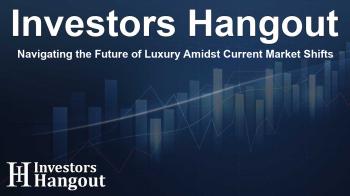Navigating the Future of Luxury Amidst Current Market Shifts

Challenges Facing the Luxury Sector
The luxury sector is currently navigating turbulent waters, as it faces disruptions not seen in over a decade. Economic factors coupled with evolving consumer expectations have created a complex landscape for luxury brands. Today’s challenges are multifaceted, involving economic uncertainties, cultural shifts, and market volatility.
Heightened Consumer Pressures
Global luxury spending is experiencing significant strain. Consumer confidence has been deeply affected by economic upheavals, including geopolitical tensions and trading complications. This has made luxury consumers more cautious, just as many were beginning to emerge from previous economic struggles. Bain & Company highlights that brands must decode this new market rhythm to maintain their relevance.
Resilience in a Volatile Environment
Despite these challenges, the luxury industry has shown remarkable resilience. Brands are urged to revisit their fundamental values, ensuring that their propositions resonate with consumers more than ever. Establishing differentiated brand identities and commitment to product quality will be key to nurturing consumer desire and restoring confidence.
Long-term Outlook for Luxury Brands
While immediate short-term demands may ease, the long-term outlook remains promising. Analysts note the growing global consumer base, especially among younger generations, which drives the enduring relevance of luxury products in consumers' lives.
Market Segment Variations
The personal luxury goods segment is undergoing a pronounced slowdown, yet Bain projects various scenarios for the market's future. A potential continued contraction of 2% to 5% could unfold as consumer behaviors evolve. Despite these projections, certain segments, particularly experiential luxury, continue to flourish, with significant opportunities in luxury hospitality and personalized experiences.
Generational Trends and Preferences
Generational behaviors are increasingly impacting the luxury landscape. Generation Z, for instance, seeks authentic engagement with brands, reflecting a blend of self-expression and conformity. Meanwhile, millennials remain cautious due to financial limitations, yet they still engage with innovative brands that connect emotionally and meaningfully.
Polarization in Performance
As luxury markets navigate the evolving landscape, a noticeable polarization is evident between leading and lagging brands. Successful brands thrive despite economic headwinds, while others struggle to maintain consumer interest. Brand engagement has diminished across generations, showcasing a need for luxury businesses to adapt their strategies.
Strategies for Future Growth
To thrive, luxury brands must prioritize quality, creativity, and authenticity, moving away from traditional marketing toward seamless customer experiences. Innovating in product offerings while diversifying engagement channels will be paramount as the luxury industry transforms.
Conclusion and Future Considerations
In conclusion, the luxury sector stands at a crossroads. The next five years present vast opportunities with a surge in potential consumers expected. To capture this growth, luxury brands must engage sufficiently with younger audiences and redefine connections that extend beyond mere transactions.
Frequently Asked Questions
What are the current challenges in the luxury sector?
The luxury sector faces challenges such as economic uncertainty, geopolitical tensions, and changing consumer behaviors, impacting spending and confidence.
How is consumer behavior shifting within luxury markets?
Consumers, particularly younger generations, are reassessing their relationships with luxury, seeking more authenticity and meaningful engagement with brands.
What segments in the luxury industry are performing well?
Experiential luxury, such as luxury hospitality and personalized travel experiences, continues to outperform traditional luxury goods in the current climate.
What strategies can luxury brands adopt for resilience?
Brands should refocus on their fundamental values, prioritize quality, and engage consumers with meaningful, personalized experiences to navigate the market shifts.
What is the long-term outlook for the luxury industry?
Despite short-term volatility, the long-term outlook remains positive, with projections for growth in the consumer base and shifting trends that favor emotional connections.
About The Author
Contact Hannah Lewis privately here. Or send an email with ATTN: Hannah Lewis as the subject to contact@investorshangout.com.
About Investors Hangout
Investors Hangout is a leading online stock forum for financial discussion and learning, offering a wide range of free tools and resources. It draws in traders of all levels, who exchange market knowledge, investigate trading tactics, and keep an eye on industry developments in real time. Featuring financial articles, stock message boards, quotes, charts, company profiles, and live news updates. Through cooperative learning and a wealth of informational resources, it helps users from novices creating their first portfolios to experts honing their techniques. Join Investors Hangout today: https://investorshangout.com/
The content of this article is based on factual, publicly available information and does not represent legal, financial, or investment advice. Investors Hangout does not offer financial advice, and the author is not a licensed financial advisor. Consult a qualified advisor before making any financial or investment decisions based on this article. This article should not be considered advice to purchase, sell, or hold any securities or other investments. If any of the material provided here is inaccurate, please contact us for corrections.

